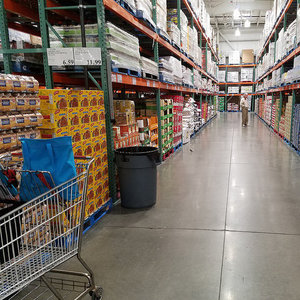Some basic economic norms shape how most retail stores operate. These include: attract as many potential shoppers as possible; make it easy for them to find what they need; and make it appealing for them to return often so that they will spend money at the store. But some members-only warehouse stores break all those rules–and succeed anyway. Listen to find out why these stores do it differently, and why, despite breaking the rules of retail, they thrive.
Listen to the story
ROBERT SIEGEL: Get as many people as possible in the door. That’s one of the basic rules of running a successful store. Another rule is make shopping easy. Well, warehouse stores – Sam’s Club and Costco – do not follow those rules, but every year Costco alone sells more stuff than Amazon. Jacob Goldstein and Robert Smith of our PLANET MONEY podcast bring us the story behind that success.
JACOB GOLDSTEIN: Lots of stores have an employee at the door to welcome you in. Costco has someone at the door to keep you out.
ROBERT SMITH: Unless you have a membership card.
GOLDSTEIN: We’re in.
SMITH: So the amazing thing about being a member here – you just sign up for membership, just renew your membership, right?
GOLDSTEIN: I paid $55 for the privilege of shopping at Costco.
SMITH: So at this point, like, you’re in the hole. Like, you’ve lost money.
GOLDSTEIN: I’m down.
SMITH: Blame Robert Price. He started the first warehouse membership store, and we asked him what he was thinking.
ROBERT PRICE: My original kind of image in my mind was like a speakeasy where somebody would feel, gee, I’ve got this special deal. And I can come in and shop, and most people can’t come in and get in here.
GOLDSTEIN: Truly like a club, like I’m a member of this insider’s club.
PRICE: Exactly right.
GOLDSTEIN: This does not feel like a cozy, little club. It feels like some giant industrial space. And in fact, when Robert Price built that first store almost 40 years ago, it wasn’t even open to regular shoppers like us.
SMITH: It was called Price Club after his name, Robert Price, and it was only for business owners. It was supposed to be a store for stores, and it was a disaster.
PRICE: The small businesses didn’t come. They didn’t spend money, and we were basically going bankrupt.
GOLDSTEIN: Robert Price was desperate. As a sort of last-ditch move to save his store, he decided to let regular people shop there, and people loved it. Pay a membership; get cheap stuff.
SMITH: Price Club expanded. One of their first employees started Costco, which later merged with Price Club. And today, warehouse stores are this huge part of the economy. They break what seem like really basic rules of how to run a store.
GOLDSTEIN: I need Ziploc bags. Normal store – you would look at the sign at the end of the aisle that says Ziploc bags.
SMITH: Yes.
GOLDSTEIN: There are no signs in Costco.
SMITH: There are no signs, but why wouldn’t you put a sign? Like, it makes no sense.
GOLDSTEIN: I asked Robert Price.
PRICE: I was adamant that we would not have signs telling people where things were because that would make it likely that they would wander through all the aisles and find other things to buy.
GOLDSTEIN: That’s a little bit devious.
PRICE: No, I mean, I agree with you. I think it was – I don’t know whether I’d use the word devious, but it was manipulative.
SMITH: Costco is not the kind of store you just pop into and buy a couple little things. You will go down every aisle. And if you buy something, you’re going to buy a lot of them.
GOLDSTEIN: Carrot juice is a good call. I like the carrot juice call.
SMITH: I don’t know.
GOLDSTEIN: Do you normally get carrot juice?
SMITH: No. It’s probably costing me more because I just bought 13 gallons of carrot juice.
GOLDSTEIN: I’ll buy one of those off of you.
SMITH: Buying in bulk, of course, is often cheaper, but for Robert Price, the bulk thing fit into this broader and really kind of surprising plan.
PRICE: Yeah. We didn’t want people to come very often, you know? It’s much better from a cost-expense point of view – is to have people come less often and buy more.
GOLDSTEIN: Every time you go to a store, the store has to pay for your parking space, has to pay the cashier to make change or authorize your credit card. So if you are a store, you would rather have a customer who comes once a month and spends say 400 bucks rather than a person who comes every week and spends a hundred bucks.
SMITH: We checked out of Costco and, of course, spent several hundred dollars, and there is one final Costco twist. Look around. You have all your stuff. There are no bags to put them in.
PRICE: If you have bags, you look like a retail store.
GOLDSTEIN: And Robert Price said Price Club and Costco never ever want to look like a retail store. It’s that speakeasy feeling Price was going for. You’re a member of this special club.
SMITH: A special club with cement floors and pallets full of stuff and vats of carrot juice for cheap. I’m Robert Smith.
GOLDSTEIN: And Jacob Goldstein, NPR News.
 © 2015 National Public Radio, Inc. Used with the permission of NPR. All rights reserved.
© 2015 National Public Radio, Inc. Used with the permission of NPR. All rights reserved. Vocabulary
- “in the hole” – in debt
- speakeasy – an illicit store or club where people bought alcoholic beverages when it was illegal to do so
- merged – combined to form a single entity
- buy in bulk – to purchase large amounts of a single item, paying less per unit than buying smaller amounts
- retail store – a shop that sells goods for consumer use, rather than for resale
Listening Comprehension Questions
- What evidence shows that breaking the rules is effective?
- How did Robert Price come up with the idea of breaking the rules?
- Why does Costco break the usual rules of retail?
- What “rules” govern most retail operations? In what ways does Costco break those rules?
Discussion Themes
- In your opinion, do the benefits of shopping at Costco outweigh the disadvantages for consumers?
- Why do you think people are willing to pay money to join shopping clubs like Costco?
Teacher’s Guide
Activate student knowledge: Open class by asking students where their household members shop for food, and how they make decisions about what and how much to buy. Based on student answers, make a list of motivations, such as product quality, price, convenience, and so on. Explain that just as shoppers make decisions about where to shop, sellers also make decisions about the strategies they use to attract and keep customers.
Introduce the story: In this story, you will learn about the surprising and unconventional economic model that the retail giant Costco has used to become enormously successful. You’ll hear from the man who started breaking the rules of how to sell products, and what he has discovered about a very different model of retail.
Active listening supports:
- Have students use the chart Retail Models to contrast conventional retail wisdom with Costco’s retail model.
- The Language Identification organizer allows students to follow along and track important phrases while listening to the story.
Reflect on the story: Take time for student reflection on the audio story and discussion questions to check for understanding.
Paired Text: Pair the AARP article Membership Warehouse Stores: Deal or No Deal? with this audio story. Have students use the article to help them make a connection to real-life shoppers. Have them evaluate the benefits and drawbacks for consumers of shopping at stores like Costco.


